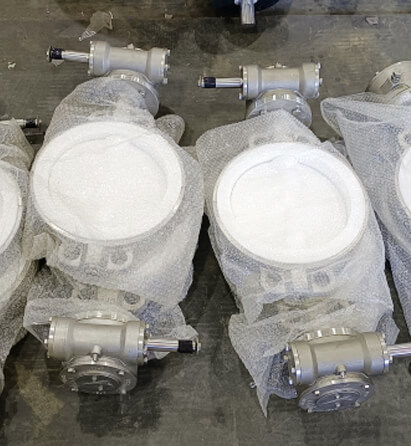Case

Case

With the continuous application of new chemical materials and the improvement of lining technology, fluorine-lined valves are favored by manufacturers and users for their safety, reliability and high cost performance. They are more and more widely used in strong corrosive process media in petroleum, chemical, pharmaceutical and other industries. However, fluorine-lined valves are not able to adapt to all corrosive working conditions. Like other valves, it is very important to choose and use fluorine-lined valves well.
The temperature used for fluorine-lined valves: currently commonly used valve lining materials include synthetic rubber (-10-120°C), polytetrafluoroethylene PTEF (-200-180°C), soluble polytetrafluoroethylene PFA (-196-260°C) , FEP F46 (-85-150°C). The actual temperature of the medium used varies according to the material and pressure. The long-term use temperature should usually be lower than the upper limit by about 30%, otherwise, the lining of each part of the valve is easily deformed, resulting in large leakage or failure of the valve to switch normally.
Especially for the fluorine-lined bellows sealing regulating valve (because the bellows are mostly made of polytetrafluoroethylene, the bellows will easily break when the pressure and pressure difference are too large), most of the manufacturer's selection samples indicate that the nominal pressure is PN≤2.5MPa , this is for insurance purposes.
Requirements for the medium of fluorine-lined valves: the medium used for fluorine-lined valves should not have hard particles, crystals, impurities, etc., so as to avoid the wear of the fluorine-lined plastic layer or bellows during the opening and closing of the valve. If the medium has hard particles, crystals, and impurities, corrosion-resistant precious metal materials can be selected according to the characteristics of the process medium, such as hard-sealed valves such as Hastelloy alloy, nickel-based alloy, and alloy steel.

The fluorine-lined regulating valve is usually made of a fluorine-lined bellows sealing structure, which has the advantages of good corrosion resistance and no leakage. When selecting, the diameter of the valve should be calculated according to the process parameters, and the normal opening should be within the range of 30-85%. If the valve diameter is too large, it will cause long-term operation with a small opening degree, and the valve adjustment performance will deteriorate. Especially in the case of small opening, not only the erosion will be intensified, but also the valve core and stem will vibrate due to the impact of the medium, and even the valve stem will be broken and the bellows will be deformed.
The PTFE lining in fluorine lined butterfly valves provides exceptional resistance to a wide range of corrosive chemicals, acids, bases, and solvents. This makes them suitable for handling aggressive and corrosive media in industries such as chemical, pharmaceutical, and petrochemical.
The PTFE lining forms a tight and reliable seal, ensuring bubble-tight shut-off and preventing any leakage. This makes fluorine lined butterfly valves ideal for applications where leak-free operation is critical, such as in hazardous or environmentally sensitive areas.
The PTFE lining reduces friction between the disc and the valve body, allowing for smooth and easy operation of the valve. This results in lower torque requirements for actuation and ensures precise control of flow.
Fluorine lined butterfly valves can withstand a wide range of temperatures, from cryogenic to high-temperature applications. They also have excellent pressure resistance, making them suitable for both low-pressure and high-pressure systems.
The PTFE lining in fluorine lined butterfly valves has excellent non-stick properties, preventing the accumulation of solids or debris on the valve disc and ensuring smooth and uninterrupted flow.
Fluorine lined butterfly valves have a compact and lightweight design, making them easy to install and suitable for applications where space is limited. Their compact design also results in lower pressure drop and reduced energy consumption.
Fluorine lined butterfly valves can be used in a wide range of industries and applications, including chemical processing, water treatment, power generation, food and beverage, and pharmaceutical. They are suitable for both on/off and throttling applications.
The PTFE lining is easy to clean and maintain, and the valve can be easily disassembled for inspection, repair, or replacement of the lining if necessary. This results in reduced downtime and maintenance costs.